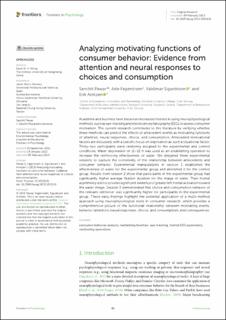| dc.contributor.author | Pawar, Sanchit | |
| dc.contributor.author | Fagerstrøm, Asle | |
| dc.contributor.author | Sigurdsson, Valdimar | |
| dc.contributor.author | Arntzen, Erik | |
| dc.date.accessioned | 2023-02-14T14:35:18Z | |
| dc.date.available | 2023-02-14T14:35:18Z | |
| dc.date.created | 2023-02-09T06:58:03Z | |
| dc.date.issued | 2023 | |
| dc.identifier.issn | 1664-1078 | |
| dc.identifier.uri | https://hdl.handle.net/11250/3050804 | |
| dc.description.abstract | Academia and business have shown an increased interest in using neurophysiological
methods, such as eye-tracking and electroencephalography (EEG), to assess consumer
motivation. The current research contributes to this literature by verifying whether
these methods can predict the effects of antecedent events as motivating functions
of attention, neural responses, choice, and consumption. Antecedent motivational
factors are discussed, with a specific focus on deprivation as such a situational factor.
Thirty-two participants were randomly assigned to the experimental and control
conditions. Water deprivation of 11–12 h was used as an establishing operation to
increase the reinforcing effectiveness of water. We designed three experimental
sessions to capture the complexity of the relationship between antecedents and
consumer behavior. Experimental manipulations in session 1 established the
effectiveness of water for the experimental group and abolished it for the control
group. Results from session 2 show that participants in the experimental group had
significantly higher average fixation duration for the image of water. Their frontal
asymmetry did not provide significant evidence of greater left frontal activation toward
the water image. Session 3 demonstrated that choice and consumption behavior of
the relevant reinforcer was significantly higher for participants in the experimental
group. These early findings highlight the potential application of a multi-method
approach using neurophysiological tools in consumer research, which provides a
comprehensive picture of the functional relationship between motivating events,
behavior (attention, neural responses, choice, and consumption), and consequences. | en_US |
| dc.language.iso | eng | en_US |
| dc.publisher | Frontiers | en_US |
| dc.rights | Navngivelse 4.0 Internasjonal | * |
| dc.rights.uri | http://creativecommons.org/licenses/by/4.0/deed.no | * |
| dc.subject | consumer behavior analysis | en_US |
| dc.subject | motivating function | en_US |
| dc.subject | eye-tracking | en_US |
| dc.subject | frontal EEG asymmetry | en_US |
| dc.subject | motivating operations | en_US |
| dc.title | Analyzing motivating functions of consumer behavior: Evidence from attention and neural responses to choices and consumption | en_US |
| dc.title.alternative | Analyzing motivating functions of consumer behavior: Evidence from attention and neural responses to choices and consumption | en_US |
| dc.type | Peer reviewed | en_US |
| dc.type | Journal article | en_US |
| dc.description.version | publishedVersion | en_US |
| dc.source.volume | 14 | en_US |
| dc.source.journal | Frontiers in Psychology | en_US |
| dc.identifier.doi | 10.3389/fpsyg.2023.1053528 | |
| dc.identifier.cristin | 2124316 | |
| cristin.ispublished | true | |
| cristin.fulltext | original | |
| cristin.qualitycode | 1 | |

